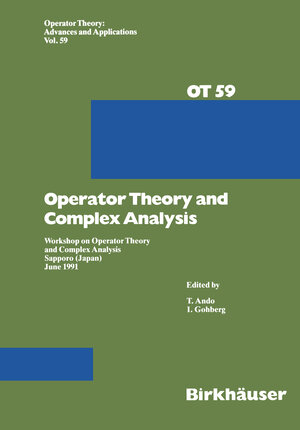
×
![Buchcover ISBN 9783034886062]()
Operator Theory and Complex Analysis
Workshop on Operator Theory and Complex Analysis Sapporo (Japan) June 1991
von T. Ando und I. GohbergInhaltsverzeichnis
- Scattering matrices for microschemes.
- 1. General expressions for the scattering matrix.
- 2. Continuity condition.
- References.
- Holomorphic operators between Krein spaces and the number of squares of associated kernels.
- 0. Introduction.
- 1. Realizations of a class of Schur functions.
- 2. Positive squares and injectivity.
- 3. Application of the Potapov-Ginzburg transform.
- On reproducing kernel spaces, the Schur algorithm, and interpolation in a general class of domains.
- 1. Introduction.
- 2. Preliminaries.
- 3. B(X) spaces.
- 4. Recursive extractions and the Schur algorithm.
- 5. H?(S) spaces.
- 6. Linear fractional transformations.
- 7. One sided interpolation.
- 8. References.
- The central method for positive semi-definite, contractive and strong Parrott type completion problems.
- 2. Positive semi-definite completions.
- 3. Contractive completions.
- 4. Linearly constrained contractive completions.
- Interpolation by rational matrix functions and stability of feedback systems: The 4-block case.
- 1. Preliminaries.
- 2. A homogeneous interpolation problem.
- 3. Interpolation problem.
- 4. Parametrization of solutions.
- 5. Interpolation and internally stable feedback systems.
- Matricial coupling and equivalence after extension.
- 2. Coupling versus equivalence.
- 3. Examples.
- 4. Special classes of operators.
- Operator means and the relative operator entropy.
- 2. Origins of operator means.
- 3. Operator means and operator monotone functions.
- 4. Operator concave functions and Jensen’s inequality.
- 5. Relative operator entropy.
- An application of Furuta’s inequality to Ando’s theorem.
- 2. Operator functions.
- 3. Furuta’s type inequalities.
- 4. An application to Ando’s theorem.
- Applications of order preserving operator inequalities.
- 1. Application to the relative operator entropy.
- 2. Application to some extended result of Ando’s one.
- The band extension of the real line as a limit of discrete band extensions, I. The main limit theorem.
- I. Preliminaries and preparations.
- II. Band extensions.
- III. Continuous versus discrete.
- Interpolating sequences in the maximal ideal space of H? II.
- 2. Condition (A2).
- 3. Condition (A3).
- 4. Condition (A1).
- Operator matrices with chordal inverse patterns.
- 2. Entry formulae.
- 3. Inertia formula.
- Models and unitary equivalence of cyclic selfadjoint operators in Pontrjagin spaces.
- 1. The class F of linear functionals.
- 2. The Pontrjagin space associated with ? ? F.
- 3. Models for cyclic selfadjoint operators in Pontrjagin spaces.
- 4. Unitary equivalence of cyclic selfadjoint operators in Pontrjagin spaces.
- The von Neumann inequality and dilation theorems for contractions.
- 1. The von Neumann inequality and strong unitary dilation.
- 2. Canonical representation of completely contractive maps.
- 3. An effect of generation of nuclear algebras.
- Interpolation problems, inverse spectral problems and nonlinear equations.
- Extended interpolation problem in finitely connected domains.
- I. Matrices and transformation formulas.
- II. Disc Cases.
- III. Domains of finite connectivity.
- Accretive extensions and problems on the Stieltjes operator-valued functions relations.
- 1. Accretive and sectorial extensions of the positive operators, operators of the class C(?) and theirparametric representation.
- 2. Stieltjes operator-valued functions and their realization.
- 3. M. S. Livsic triangular model of the M-accretive extensions (with real spectrum) of the positive operators.
- 4. Canonical and generalized resolvents of QSC-extensions of Hermitian contractions.
- Commuting nonselfadjoint operators and algebraic curves.
- 1. Commuting nonselfadjoint operators and the discriminant curve.
- 2. Determinantal representations of real plane curves.
- 3. Commutative operator colligations.
- 4. Construction of triangular models: Finite-dimensional case.
- 5. Construction of triangular models: General case.
- 6. Characteristic functions and the factorization theorem.
- All (?) about quasinormal operators.
- 2. Representations.
- 3. Spectrum and multiplicity.
- 4. Special classes.
- 5. Invariant subspaces.
- 6. Commutant.
- 7. Similarity.
- 8. Quasisimilarity.
- 9. Compact perturbation.
- 10. Open problems.
- Workshop Program.
- List of Participants.



